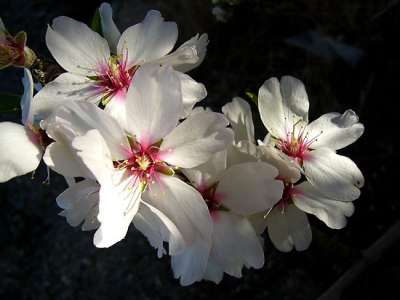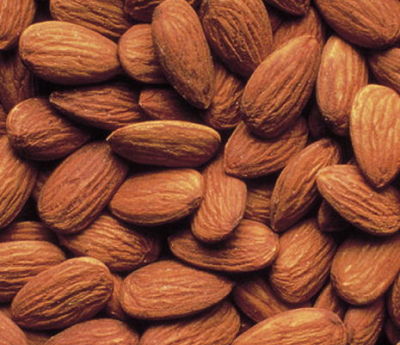
Backyard nut trees
 In addition to expanding
our fruit orchard,
this winter we plan to branch out into nuts. In the past, I've
steered clear of nut trees for a couple of very good reasons --- most
nut trees are much bigger than fruit trees and it takes a long time to
crack all of those nuts. However, I just discovered that almonds
are peach-sized trees sometimes no more than 15 feet tall, and Mark has
promised to invent an automatic nutcracker for me by the time they
bear. As you can see, almond flowers are also so beautiful that
the trees are sometimes grown as ornamentals. Time to pick out
some nuts!
In addition to expanding
our fruit orchard,
this winter we plan to branch out into nuts. In the past, I've
steered clear of nut trees for a couple of very good reasons --- most
nut trees are much bigger than fruit trees and it takes a long time to
crack all of those nuts. However, I just discovered that almonds
are peach-sized trees sometimes no more than 15 feet tall, and Mark has
promised to invent an automatic nutcracker for me by the time they
bear. As you can see, almond flowers are also so beautiful that
the trees are sometimes grown as ornamentals. Time to pick out
some nuts!
A quick search turns up
the following nuts being sold to backyard growers:
| Variety |
Zone |
Spacing |
Pros and Cons |
| Almond |
5 - 9 |
10 - 22 ft. |
With new, self-pollinating
varieties on the market, the small size of almonds makes them easy to
fit into a nook in your garden. On the other hand, rain and high
humidity in July and August can rot the nuts. |
| Black Walnut |
5 - 9 |
30 - 40 ft. |
Very large trees with very hard
nuts. We actually have dozens of these growing on our property
already, but I rarely bother to gather the fruits since you have to
crack them with a hammer. |
| Butternut | 4 - 9 |
30 - 40 ft. |
Very winter hardy and tolerant
of poor soil. However, most of our native butternut trees have
been killed by a blight, so be sure to pick out a resistant variety.
Shells are very hard and the tree is large and needs a pollinator. |
| Carpathian Walnut |
5 - 9 |
25 - 40 ft. |
The Carpathian Walnut is
significantly more cold hardy than the English Walnut, but is still
damaged by spring frosts. The nut is supposed to be very similar
to the walnuts you buy in the store. The trees are large and
require a pollinator. |
| Chinese Chestnut |
4 - 9 |
20 - 40 ft. |
The trees are large and two
trees are required for good fruit set. The prickly cases around
the fruits are very tough on bare feet. Chestnuts don't store
well and must be harvested every day or two or they will rot on the
ground. All of that said, though, chestnuts are delicious and
have a thin shell that can be pried off without a nutcracker --- I can
bite them open in a pinch. Chestnuts are the most common nut
trees grown in our region. |
| English Walnut | 5 - 9 |
40 - 50 ft. |
Sensitive to cold weather and
spring frosts. Very large trees, but most don't require a
pollinator. These are the walnuts you buy in the store, with
relatively thin shells and a taste everyone can enjoy. |
| Hazelnut/Filbert |
5 - 8 |
15 - 20 ft. |
We've already planted a few
hybrid hazels and wrote
extensively about them here. In short, they're small and easy
to fit into your backyard, but you need to pick out a blight-resistant
version and plant two for pollination. |
| Heartnut | 5 - 8 |
20 - 25 ft. |
This is a variety of Japanese
Walnut. It seems to be mostly a gimmick --- people like the
heart-shaped nut. It needs a pollinator. |
| Hickory | 5 - 8 |
20 - 40 ft. |
Large tree that needs a
pollinator. Nut shells are very hard and the meats are small.
If I want hickory nuts, I'll gather them out of the woods. |
| Pecan | 4 - 9 |
40 ft. |
The pecan is a southern
specialty, but some hardy varieties can be grown as far north as zone
4. Like walnuts and almonds, the nuts are familiar and delicious.
The downside is size and the need for a pollinator. |
| Stone Pine |
varies |
??? |
The Korean
Nut Pine is hardy down to zone 4, while the more common Stone Pine (Pinus
pinea) is only hardy to zone 7. They seem to require very
little work, but take more than a decade to bear. I can't seem to
find any real spacing data on the internet --- some sites say you can
plant them 10 feet apart, while others tell you to go for 40 feet. |
As I mentioned, we're already trying out hybrid hazelnuts (highly recommended, though they're not big enough to fruit yet), and I planted a Korean Nut Pine from seed last year (which is now about an inch tall.) Of the other types of nuts, I'm most interested in trying out an almond in the sunniest part of the garden, where perhaps our humidity won't be so devastating, and an English Walnut in the shadiest part of the yard, where I might trick it
 into flowering late after
hard spring frosts have passed us by. Almonds (part of my
breakfast at the moment) and walnuts (integral to pesto) also happen to
be the nuts most frequently served in our household's meals.
into flowering late after
hard spring frosts have passed us by. Almonds (part of my
breakfast at the moment) and walnuts (integral to pesto) also happen to
be the nuts most frequently served in our household's meals.I've read varying reports about whether you need to buy named varieties or can just sprout shelled nuts out of the grocery store. Almonds seem to be a bad candidate for growing from seed since the nuts are bitter in most of the offspring, so I'll probably go ahead and buy named varieties for both of our nut additions.
As you can tell, I'm still very much in the research stage, but I thought you might enjoy some of the information I'm digging up. I'm very curious to hear about your own experience with growing nut trees in your backyard. Which trees did you choose and why? How did your experiment turn out?
Want more in-depth information? Browse through our books.
Or explore more posts by date or by subject.
About us: Anna Hess and Mark Hamilton spent over a decade living self-sufficiently in the mountains of Virginia before moving north to start over from scratch in the foothills of Ohio. They've experimented with permaculture, no-till gardening, trailersteading, home-based microbusinesses and much more, writing about their adventures in both blogs and books.
Want to be notified when new comments are posted on this page? Click on the RSS button after you add a comment to subscribe to the comment feed, or simply check the box beside "email replies to me" while writing your comment.

I'm about to put in a home orchard.
Spending way too much money to have to have the area cleared and sloped : )
It's the western side of my front yard all grown up with weeds and having a steep drop off.
My landscaper/grader seems to know something about drainage, so hopefully I'm in good hands!
In any case, thanks for the nut tree recommendations.
I'm in Zone 8, North Louisiana, which is really East Texas (by my tastes, low humidity, hot, not enough rain), but I'm dreaming about almonds, persimmons, blueberries, blackberries, anything easy-ish to grow in this weird climate.
I LOVE your blog! Thanks for putting up any and all research, comments, observations, etc.
Lloyd --- Fascinating! Thanks so much for writing about your forty year old experiment. That's what I was afraid of --- a tree that makes hard nuts to crack. We've got lots of wild black walnuts if we were willing to use a hammer on concrete to get to the nuts, but there never seems to be time for so much effort with other garden tasks.
I hope some othere readers will chime in with their experiences with Carpathian walnuts.